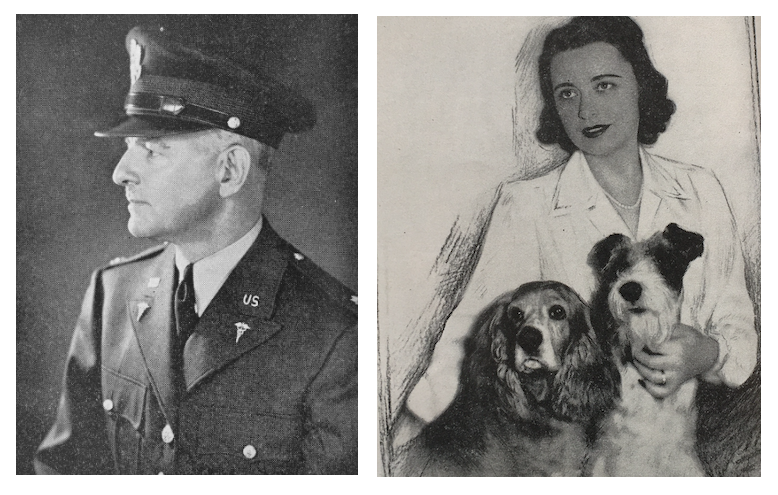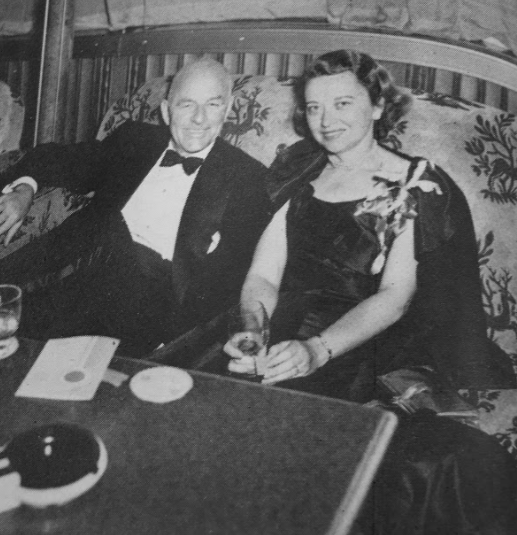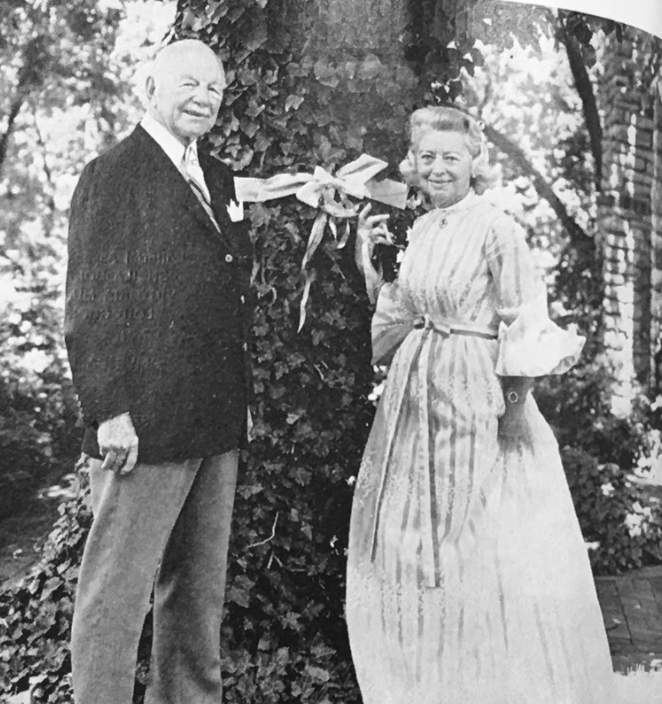The course of true love was anything but smooth for Lillian and Dr. Rex Diveley. The couple was involved in not one, but two serious car accidents in a short span of time during their courtship. A different pair might have termed the relationship star-crossed, wished each other well, and proceeded on their separate ways. Instead, they persevered. When they finally wed, the marriage lasted for more than 40 years.

Rex was the son of Nellie and George Diveley, who was a wholesale grocer. He attended Baker University and graduated from The University of Kansas. (At some point, he also studied at Cornell University.) Rex served with Army Medical Corps in France during World War I, rising from a lieutenant to a captain. Shortly after that, he completed a residency at Johns Hopkins. His career would be that of an orthopedic surgeon. Beginning in 1927, he and Dr. Franklin D. Dickson were partners in the Dickson-Diveley Clinic. (Through the years, the duo would do a tremendous amount of pro bono medical treatment, in addition to their other responsibilities.) Rex would be affiliated with Saint Luke’s Hospital for 52 years. He would also find time to teach at The University of Kansas Medical School. Rex was active for many years in the Kansas City Southwest Clinical Society, which held an annual conference in the autumn. In October 1930, he made the papers both for heading the clinics during the conference, and, a few weeks later, for a scary situation he experienced as an airplane passenger. In treating accident victims, Rex sometimes had to go to them. In October 1930, he and a pilot flew to Arkansas City, Kansas, to see a patient. They arrived after dark. The police were shining their car lights on the landing field, but the pilot had to fly low to see them. (He was expecting to spot the hangars, but they had been destroyed in a fire a few weeks earlier.) They landed safely, but it was enough of a close call to merit a write-up. The following July, a man injured in a polo accident sent his private plane to pick up Rex and bring him to Colorado Springs.

Dr. and Mrs. Rex L. Diveley photographed on board R.M.S. Queen Mary during their recent Atlantic crossing. In air trips over the continent they lingered particularly in Sweden and Paris. In England they toured medical centers which Dr. Diveley headed during the war. Reprinted from October 23, 1948
Rex was in demand as a speaker, both at meetings and on the radio. In March 1933, he gave a talk on WDAF on the subject of infantile paralysis. As president of the Kansas City Southwest Clinical Society, he gave the opening address at the October 1934 conference. His topic? Medical economics.
Lillian Schroll was the daughter of Hilda and Joseph Schroll. In her youth, she studied piano. Lillian was briefly married to a man whose last name was Marrs. As was customary at the time, she kept that name after they parted. For most of the 1930s, Lillian was a designer with the Donnelly Garment Company (if that name doesn’t seem familiar, just think of Nelly Don).
Lillian and Rex’s first car crash took place in 1934. Her right kneecap was fractured. In April 1935, he was to perform an operation in Butler, Missouri. They were in his new Chrysler, not far from their destination, when the next accident occurred. Lillian and Rex came over a hill. In front of them was a truck carrying mules – and it had stopped because it was out of gas. Another car was approaching in the opposite lane. Rex hit the brakes, but couldn’t stop in time to avoid a collision. This time, Lillian had a lacerated knee (again, the right one), but Rex suffered a skull fracture and head lacerations. His recovery was hampered by an infection (described as being in his face) a month later, for which he was hospitalized for the better part of a week.
The Kansas City Star, in its coverage of the April 1935 accident noted that Lillian was divorced and Rex was unmarried. They would remedy that situation in February 1939. Friends were invited to Rex’s apartment at the Sophian Plaza for a going away party. Supposedly, he was leaving alone for South America. Lillian had also had a trip scheduled – two months in Europe – but she had quietly canceled that. In on the secret were Dr. Dickson, (Frank, as he was known, learned of the plan only that morning) and Frances Keith, Lillian’s roommate at the Woodlea Hotel. The bride was 30, and the groom was 45.
Rex’s hobby was photography. For their honeymoon, Lillian had a new camera that he had given her. The Star noted, “Dr. Diveley left with sound and color motion picture equipment valued at $700.” Incan ruins were slated to be only one of the many stops on their air tour. These were clearly not the sort of newlyweds who stay in and order room service. By November, Major Rex L. Diveley of the medical reserve was prepared to show his film, Wings Over South America, at an officers’ meeting.
The Diveleys should have been able to settle down and enjoy themselves. At the time of their marriage, the Star had made it clear that Rex was not all work and no play: “The physician’s summer home is at Lake Lotawana. He is a member of the Kansas City Country Club, Mission Hills Country Club, the Kansas City Club and the Kansas City Athletic Club.” Following their return from South America, Lillian served as a coordinator and commentator for fashion shows, for groups such as the women’s auxiliary of the Jackson County Medical Society and the Women’s City Club, as well as for Nelly Don. Alas, any thought of cozy domesticity had to be put aside with the coming of World War II.
The Diveleys were off to Washington, D.C. in July 1942. From there, Rex became chief orthopedic consultant for the American expeditionary forces in the European theater. Lillian returned home. At a hospital in North Africa, Rex filmed a group of doctors and dentists from Kansas City hard at work and in their off-hours. He sent the film to Lillian. It was shown in May 1943 at a gathering of the wives at the home of one of the doctors. As the Star reported, “They ran the picture several times, and real slow, so as not to miss a detail. And then they talked and laughed about it, and some cried some more.”
That October, Rex was in town for the Kansas City Southwest Clinical Society conference. One evening attendees were treated to a showing of two of his films at the Music Hall: Medical Service in North Africa and The Eighth Air Force at Work. The Star featured a photo of Rex, who by then was Colonel Diveley, with his dog, Boots, at their Sophian Plaza apartment.
During 1944 and 1945, much of Rex’s work focused on establishing convalescent centers and camps. He was awarded the Bronze Star Medal in 1945 and was discharged that November. The following year, he received the Legion of Merit.

That yellow ribbon means a dancing good time for friends of Dr. Rex Diveley at his birthday celebration – an annual affair planned by Mrs. Diveley to include other June birthday babies. Reprinted from June 29, 1974
1946 saw Lillian and Rex take up housekeeping at 5120 Summit Drive. Rex was the president of the Saint Luke’s Hospital Staff from 1946 through 1947. The Diveleys were a very social couple. Rex served as president of The Kansas City Country Club and also of the Racquet Club at the Kansas City Club. He was also a director of the Broadway Bank. Lillian was a charter member of the Westport Garden Club. She served as its president, and shortly before her death, received its medal of merit. She was also active in the Garden Club of America, the Nelson Gallery, and L’Alliance française.
Beginning in the 1940s, Dr. Rex Diveley and Herbert O. Peet always celebrated their June birthdays together. This was a tradition that would continue for more than 30 years, with Margot Munger Peet and Lillian serving as hostesses.
Travel would be a constant in the Diveleys’ lives. The archives of The Independent document them on ocean voyages, touring Army hospitals, hunting for French provincial antiques in Paris and smaller towns, meeting up with Rex’s friends from military days, attending fashion shows, and dropping into glamorous nightspots. A very young Queen Elizabeth II even invited them to a garden party. On one trip to Africa, they photographed seven game reserves.
Rex Diveley died in 1980. Prior to her death in 1989, Lillian donated funds to the University of Missouri-Kansas City to create a professorship and chair in orthopedic surgery in his memory. For people whose romance survived some bumps in the road at the outset, they certainly seem to have had fun.
For further reading:
Matheny, Edward T., Jr. The Presence of Care: The History of Saint Luke’s Hospital in Kansas City. Kansas City, Missouri: Saint Luke’s Hospital Press, 1997.
Also featured in the February 6, 2021 issue of The Independent
By Heather N. Paxton